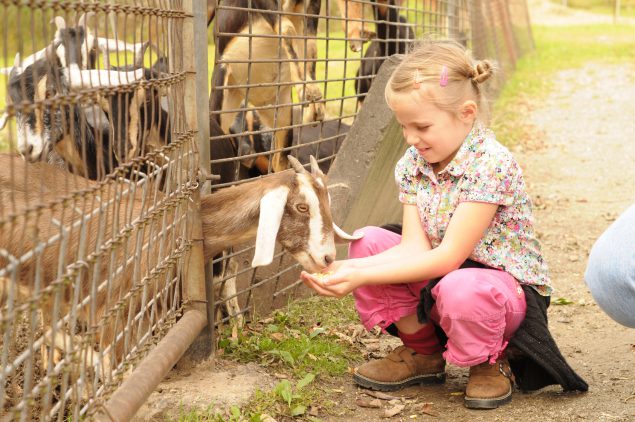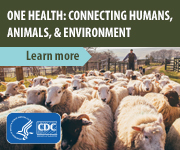Stay Healthy at Animal Exhibits

Interacting with animals at fairs, educational farms, petting zoos, summer camps, aquariums, schools, and other places can be educational and fun, and helps people learn about and experience animals they may not see in their daily lives. However, it is important to know that animals sometimes carry germs that can make people sick.
Every year, many people get sick after visiting an animal exhibit. From 2010-2015, about 100 outbreaks of illness in people linked to animals in public settings like zoos, fairs, and educational farms were reported to public health officials. Some of the most common harmful germs people get from animals at exhibits are E. coli O157:H7, Cryptosporodium, and Salmonella infections, but there are also many other types of germs that can spread between animals and people. Children 5 years of age and younger, people with weakened immune systems, and adults over 65 years of age are more likely to get sick from the germs animals can carry, and should take extra precautions at animal exhibits. If you forget to wash your hands after petting an animal, or bring food or drinks into an area with animals, you increase your chance of getting sick. Even animals that look clean and healthy can carry harmful germs, and areas where animals live or roam can be contaminated – you don’t have to touch an animal to get sick.
How to stay healthy if you visit an animal exhibit or have contact with animals in a public setting

Animal encounters such as touching or petting, feeding, and holding animals are becoming more popular, especially at zoos and aquariums. An animal exhibit can be anything from a large zoo to a livestock show at the county fair. You might also encounter animals at schools, as part of local festivals, or just out and about. Wherever you are, it’s important to know ways to stay healthy while enjoying animals.
Protect yourself and your family
Wash your hands

- Find where the handwashing stations are located.
- Wash your hands right after touching animals or anything in the areas where they live, roam, or eat.
- Wash your hands when you leave animal areas, even if you didn’t touch the animals; hands should still be washed if you wore gloves.
- Running water and soap are best, but if they are not available, use an alcohol-based hand sanitizer that contains at least 60% alcohol and wash your hands with soap and running water as soon as you can.
Keep food and animals separate
- Don’t eat or drink around animals, and keep food and drinks away from animal areas.
- Don’t share your food with the animals, even if you think the food is part of the animal’s regular diet. Animals should eat the food provided for them by the animal exhibit.
- Don’t eat or drink raw (unpasteurized) products. Raw products made or sold at animal exhibits may include: milk, cheese, cider, or juice.
Keep children safe around animals
- Always supervise children around animals.
- Children 5 years of age and younger should not have contact with reptiles, amphibians, or live poultry because these animals are more likely to make them sick.
- Leave items such as strollers, pacifiers, cups, or toys outside the exhibit.
- Don’t let children to put their thumbs, fingers, or objects (like pacifiers) in their mouths when they’re around animals or in an animal area.
- Don’t let children sit or play on the ground in animal areas.
- Teach children to approach animals with caution and follow the rules. Do not let children put their fingers or objects near an animal’s mouth, even if the animal seems friendly. Make sure to follow any rules provided on signs or verbally by the staff. For example, some contact exhibits have a “two-finger touch” rule.
If you work at, manage, or design animal exhibits
The Compendium of Measures to Prevent Diseases Associated with Animals in Public Settings [PDF – 25 pages]external icon provides standardized recommendations for public health officials, veterinarians, animal venue operators, animal exhibitors, and others concerned with disease control and with minimizing risks associated with animals in public settings. NASPHV also provides a toolkitexternal icon with examples of regulations on animal exhibitions, printable posters with messages on how to stay safe while enjoying animals, and a check list of petting zoo best practices.
Even healthy animals can carry germs that might make visitors sick. When designing an exhibit, you want to protect your animals and your visitors, while preserving the fun and education.
Design exhibits in ways that will help to prevent the spread of disease:
- Provide stations for handwashing at the exits of animal exhibits, including some that are low enough for children to reach.
- Educate staff and visitors on how to prevent illness after being around animals.
- Provide signs for guests on when and how to wash their hands, where people can eat, and areas for the animals. Use plain language and pictures.
- Keep dining and animal areas separate.
- Train staff and educate visitors on diseases animals may carry and how to prevent them.
- Educate your staff on the risks of working around animals. Encourage them to talk to visitors about safety around animals, such as handwashing.
- Provide your staff with resources on safety at animal exhibits, especially if your staff includes veterinarians or healthcare providers.
State public health veterinarians are the local and state professionals who regularly work with physicians, emergency rooms, health departments, veterinarians, fair boards, local officials, schools, legislators, and communities on preventing and controlling diseases that people can get from animals and animal products. CDC works closely with the National Association of State Public Health Veterinarians (NASPHV)external icon to create guidance and recommendationsexternal icon for visitors to animal exhibits as well as people who manage or design exhibits.
- Websites
- Educational posters (available in multiple languages):
- Poster: Wash Hands When Leaving Animal Exhibits pdf icon[PDF – 1 page]
- Know How to be Safe Around Animals! pdf icon[PDF – 1 page]
- 5 Things to do right after visiting animals pdf icon[PDF – 1 page]
- Stay healthy around animals pdf icon[PDF – 1 page]
- How Infected Backyard Poultry Could Spread Bird Flu to People pdf icon[PDF – 2 pages]
- Take Action to Prevent the Spread of Flu Between Pigs and People pdf icon[PDF – 2 pages]
- Podcasts
- Wash Your Hands if You Pet That Bunny [7:15 minutes]: more information on reducing health risks for visits to state fairs, petting zoos, and pet stores
- I Love Petting Zoos! [3:27 minutes] [Spanish]
- For Professionals
- Compendium of Measures to Prevent Diseases Associated with Animals in Public Settingsexternal icon
- NASPHV Animal in Public Settings Toolkitexternal icon
- Q Fever Safety at Livestock Birthing Exhibits: Information for Operators and Managers pdf icon[PDF – 2 pages]
- Association of Zoos and Aquariums—Policy for Animal Contact with the General Public external icon
